1998 PONTIAC GRAND PRIX service
[x] Cancel search: servicePage 255 of 402
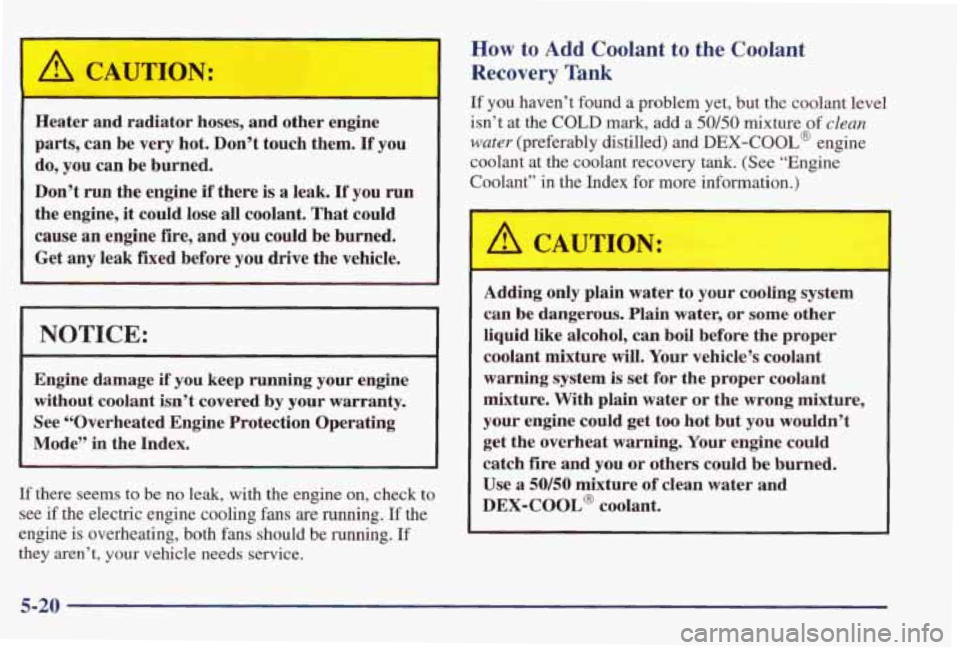
I A CAUTION: I
Heater and radiator hoses, and other engine
parts, can be very hot. Don’t touch them.
If you
do, you can be burned.
Don’t run the engine
if there is a leak. If you run
the engine, it could lose all coolant. That could
cause
an engine fire, and you could be burned.
Get any leak fined before you drive the vehicle.
NOTICE:
Engine damage if you keep running your engine
without coolant isn’t covered by your warranty.
See “Overheated Engine Protection Operating
Mode” in the Index.
If there seems to be no leak, with the engine
on, check to
see if the electric engine cooling fans are running. If the
engine is overheating,
both fans should be running. If
they aren’t, your vehicle needs service.
How to Add Coolant to the Coolant
Recovery Tank
If you haven’t found a problem yet, but the coolant level
isn’t at the
COLD mark, add a 50/50 mixture of clean
wuter (preferably distilled) and DEX-COOL@ engine
coolant at the coolant recovery tank. (See “Engine
Coolant”
in the Index for more information.)
Adding only
plain water to your cooling system
can
be dangerous. Plain water, or some other
liquid like alcohol, can boil before the proper
coolant mixture
will. Your vehicle’s coolant
warning system
is set for the proper coolant
mixture. With plain
water or the wrong mixture,
your engine could get too hot but you wouldn’t
get the overheat warning. Your engine could
catch fire and you or others could
be burned.
Use
a 50/50 mixture of clean water and
DEX-COOL@ coolant.
5-20
Page 276 of 402

Section 6 Service and Appearance Care
Here you will find information about the care of your vehicle. This section begins with service and fuel informa\
tion,
and then it shows how to check important fluid and lubricant \
levels. There
is also technical information about your
vehicle, and
a part devoted to its appearance care.
6-2
6-3
6-5
6-6
6-8
6-8
6-
13
6-20
6-22
6-26
6-32
6-33
6-36
6-37
6-44 Service
Fuel
Fuels in Foreign Countries
Filling Your Tank
Filling a Portable Fuel Container Checking Things Under the Hood
Engine Oil Air Cleaner
Automatic Transaxle Fluid
.
Engine Coolant
Windshield Washer Fluid
Brakes
Battery
Bulb Replacement
Windshield Wiper Blade Replacement 6-44
6-52
6-53 6-55
6-56
6-57
6-59
6-60
6-6 1
6-6
1
6-62
6-68
6-70
6-70 Tires
Appearance Care
Cleaning the Inside of
Your Vehicle
Care
of the Safety Belts and Built-in Child
Restraint Harness Cleaning the Outside
of Your Vehicle
Cleaning Aluminum Wheels
(If Equipped)
Underbody Maintenance
Appearance Care Materials Chart
Vehicle Identification Number (VIN)
Service
Parts Identification Label
Electrical System
Capacities and Specifications Normal Maintenance Replacement
Parts
Air Conditioning Refrigerants
Page 277 of 402
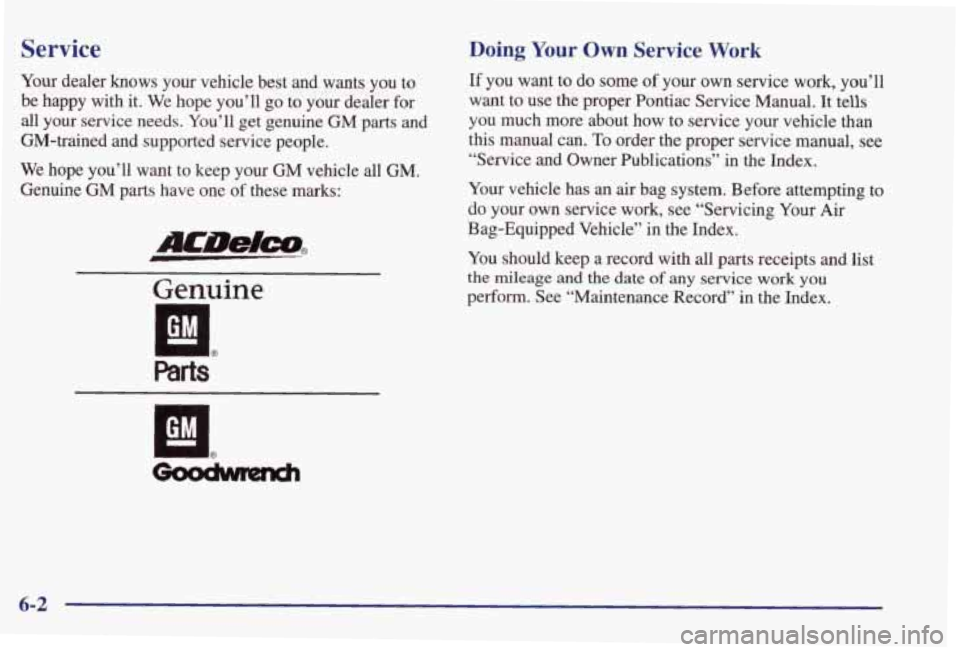
Service
Your dealer knows your vehicle best and wants you to be happy with it. We hope you’ll go to your dealer for
all your
service needs. You’ll get genuine GM parts and
GM-trained and supported service people.
We hope you’ll want
to keep your GM vehicle all GM.
Genuine GM parts have one of these marks:
1 EJ
Genuine
Doing Your Own Service Work
If you want to do some of your own service work, you’ll
want to use the proper Pontiac Service Manual. It tells
you much more about how to service your vehicle than
this manual can. To order the proper service manual, see
“Service and Owner Publications” in
the Index.
Your vehicle has an
air bag system. Before attempting to
do your own service work, see “Servicing Your Air
Bag-Equipped Vehicle” in the Index.
You should keep a record with all
parts receipts and list
the mileage and the date of any service work you
perform. See “Maintenance Record” in the Index.
6-2
Page 278 of 402
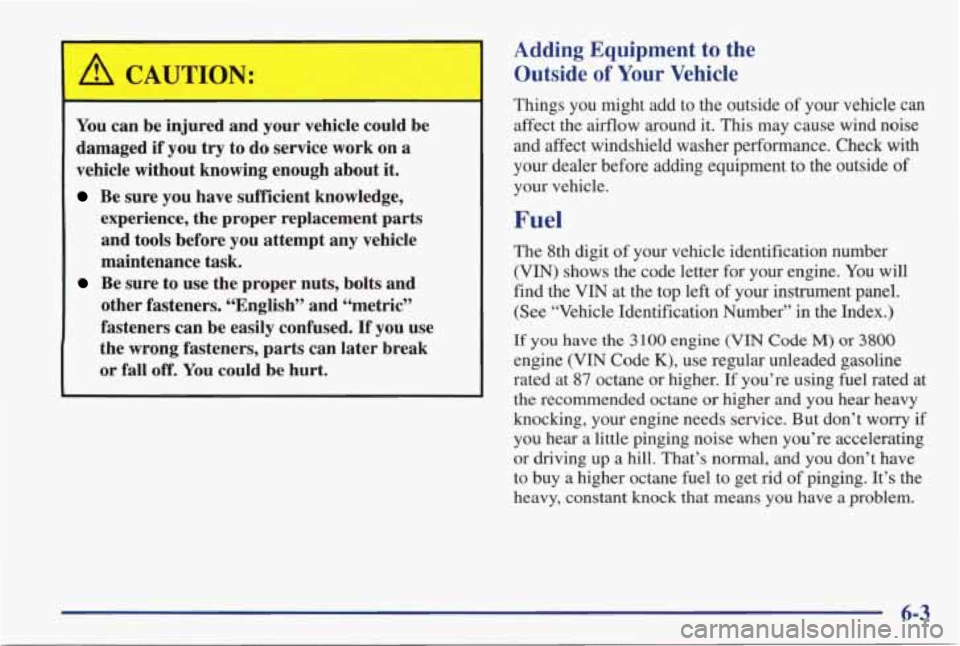
A CAUTION:
You can be injured and your vehicle c!!!d be
damaged
if you try to do service work on a
vehicle without knowing enough about it.
Be sure you have sufficient knowledge,
experience, the proper replacement parts
and tools before you attempt any vehicle
maintenance task.
Be sure to use the proper nuts, bolts and
other fasteners. “English” and “metric”
fasteners can be easily confused.
If you use
the wrong fasteners,
parts can later break
or fall
off. You could be hurt.
Adding Equipment to the
Outside
of Your Vehicle
Things you might add to the outside of your vehicle can
affect the airflow around
it. This may cause wind noise
and affect windshield washer performance. Check with
your dealer before adding equipment to the outside of
your vehicle.
Fuel
The 8th digit of your vehicle identification number
(VIN) shows the code letter for your engine. You will
find the VIN at the top
left of your instrument panel.
(See “Vehicle Identification Number” in the Index.)
If you have the 3100 engine (VIN Code M) or 3800
engine (VIN Code K), use regular unleaded gasoline
rated at
87 octane or higher. If you’re using fuel rated at
the recommended octane or higher and you hear heavy
knocking, your engine needs service. But don’t worry
if
you hear a little pinging noise when you’re accelerating
or driving up a hill. That’s
normal, and you don’t have
to buy a higher octane
fuel to get rid of pinging. It’s the
heavy, constant knock
that means you have a problem.
6-3
Page 279 of 402
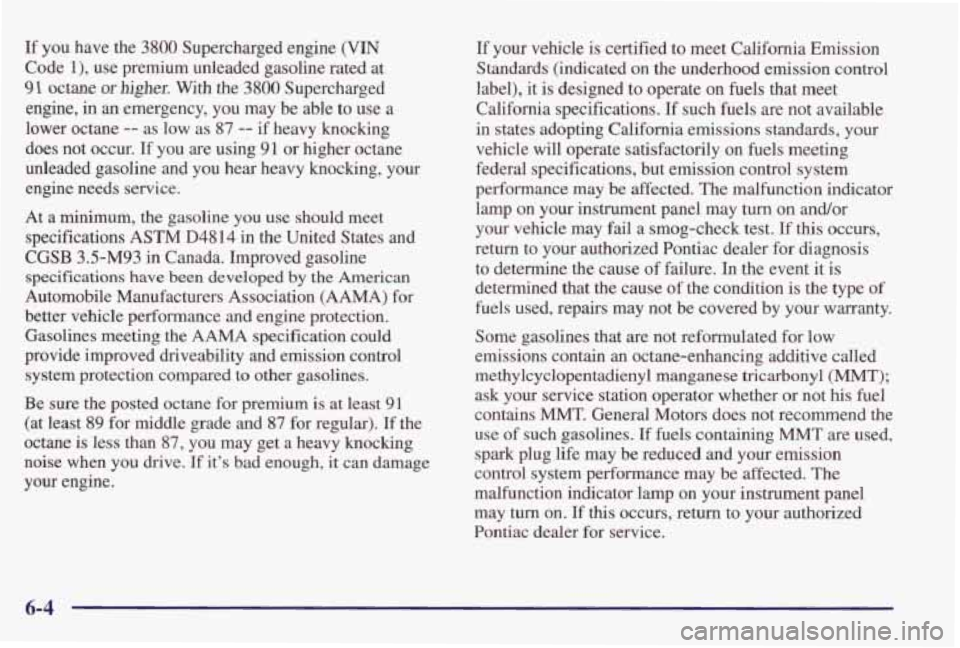
If you have the 3800 Supercharged engine (VIN
Code l), use premium unleaded gasoline rated at
91 octane or higher. With the 3800 Supercharged
engine, in
an emergency, you may be able to use a
lower octane
-- as low as 87 -- if heavy knocking
does not occur. If you are using 91 or higher octane
unleaded gasoline and you hear heavy knocking, your engine needs service.
At a minimum, the gasoline you
use should meet
specifications
ASTM D4814 in the United States and
CGSB 3.5-M93 in Canada. Improved gasoline
specifications have been developed by the American
Automobile Manufacturers Association
(AAMA) for
better vehicle performance and engine protection. Gasolines meeting
the AAMA specification could
provide improved driveability and emission control system protection compared to other gasolines.
Be sure the posted octane for premium
is at least 91
(at least 89 for middle grade and 87 for regular). If the
octane is less than
87, you may get a heavy knocking
noise
when you drive. If it’s bad enough, it can damage
your engine.
If your vehicle is certified to meet California Emission
Standards (indicated on the underhood emission control
label), it is designed to operate on fuels that meet
California specifications. If such fuels are not available
in states adopting California emissions standards, your
vehicle will operate satisfactorily on fuels meeting
federal specifications, but emission control system
performance may be
affected. The malfunction indicator
lamp on your instrument panel may turn on andor
your vehicle may fail a smog-check test.
If this occurs,
return to your authorized Pontiac dealer for diagnosis
to determine the cause of failure.
In the event it is
determined that the cause
of the condition is the type of
fuels used, repairs may not be covered by your warranty.
Some gasolines that are not reformulated for low
emissions contain
an octane-enhancing additive called
methylcyclopentadienyl manganese tricarbonyl
(MMT);
ask your service station operator whether or not his fuel
contains
MMT. General Motors does not recommend the
use
of such gasolines. If fuels containing MMT are used,
spark plug life may be reduced and your emission
control system performance may be affected. The
malfunction indicator lamp on your instrument panel
may turn on. If
this occurs, return to your authorized
Pontiac dealer for service.
6-4
Page 294 of 402
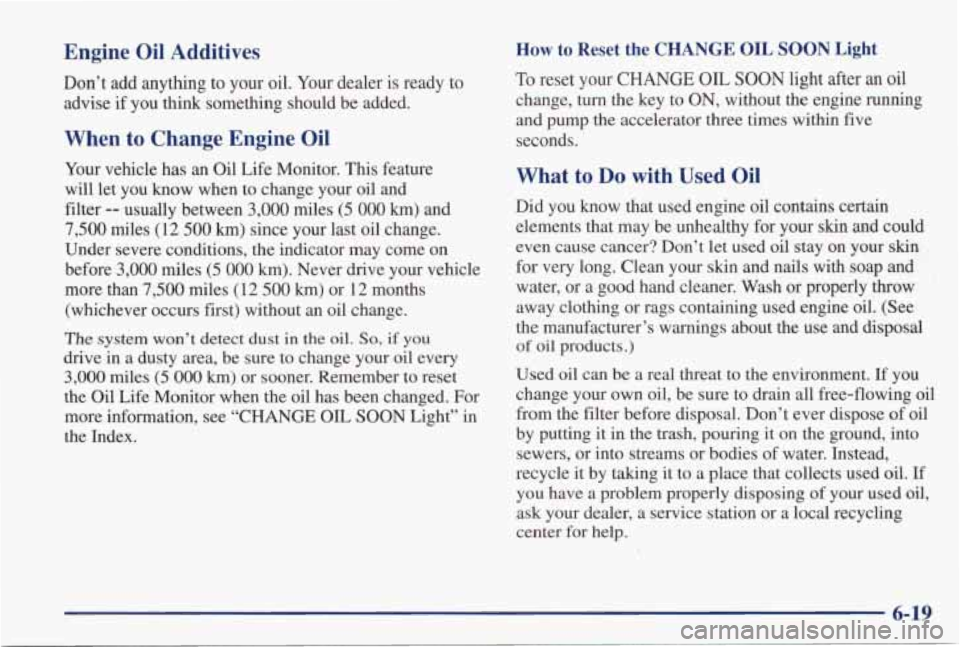
Engine Oil Additives
Don’t add anything to your oil. Your dealer is ready to advise
if you think something should be added.
How to Reset the CHANGE OIL SOON Light
When to Change Engine Oil
Your vehicle has an Oil Life Monitor. This feature
will let you know when to change your oil and
filter
-- usually between 3,000 miles (5 000 km) and
7,500 miles (12 500 km) since your last oil change.
Under severe conditions, the indicator may come
on
before 3,000 miles (5 000 km). Never drive your vehicle
more than
7,500 miles (12 500 km) or 12 months
(whichever occurs first) without an oil change.
The system won’t detect dust in the oil. So, if you
drive in a dusty area, be sure to change your oil every
3,000 miles (5 000 km) or sooner. Remember to reset
the Oil Life Monitor when the oil has been changed. For
more information, see “CHANGE
OIL SOON Light” in
the Index.
To reset your CHANGE OIL SOON light after an oil
change, turn
the key to ON, without the engine running
and pump the accelerator three times within five seconds.
What to Do with Used Oil
Did you know that used engine oil contains certain
elements that may be unhealthy for your skin and could
even cause cancer? Don’t let used oil stay on your skin
for very long. Clean your skin and nails with soap and
water, or a good hand cleaner. Wash or properly
throw
away clothing or rags containing used engine oil. (See
the manufacturer’s warnings about the use and
disposal
of oil products.)
Used oil can
be a real threat to the environment. If you
change your own oil, be sure to drain
all free-flowing oil
from the filter before disposal. Don’t ever dispose of oil
by putting it in the trash, pouring it on the ground, into
sewers, or into streams or bodies of water. Instead,
recycle it by taking it to a place that collects used oil.
If
you have a problem properly disposing of your used oil,
ask your dealer, a service station or a local recycling
center for help.
6-19
Page 295 of 402
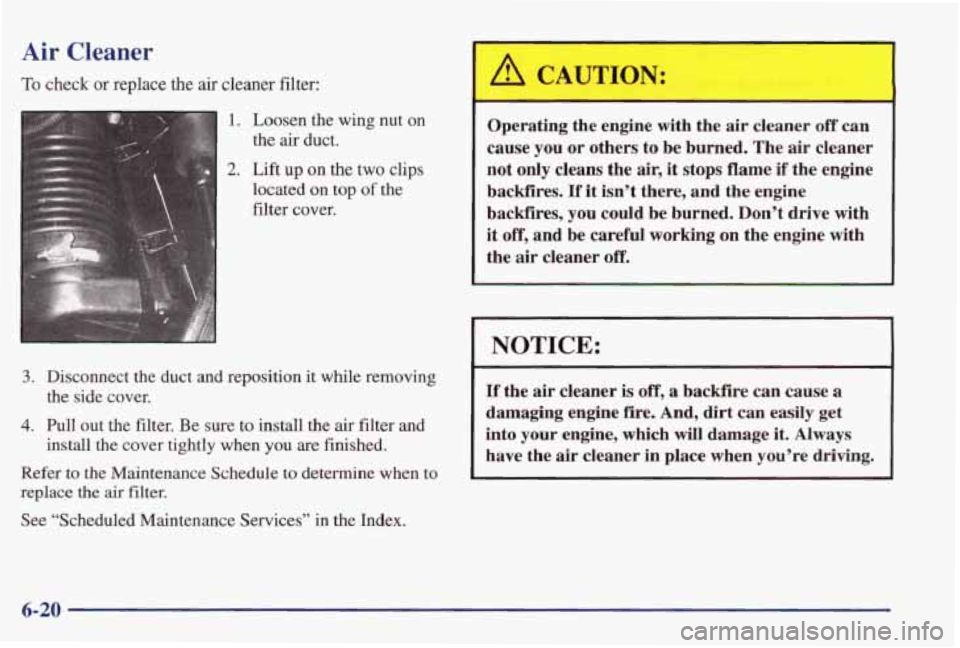
Air Cleaner
To check or replace the air cleaner filter:
1. Loosen the wing nut on
the air duct.
2. Lift up on the two clips
located
on top of the
filter cover.
3. Disconnect the duct and reposition it while removing
4. Pull out the filter. Be sure to install the air filter and
install the cover tightly when you are finished. the side cover.
Refer to the Maintenance Schedule to determine when
to
replace the air filter.
See “Scheduled Maintenance Services” in the Index.
I A CAUTION:
Operating the engine with the air cleaner off can
cause you
or others to be burned. The air cleaner
not
only cleans the air, it stops flame if the engine
backfires.
If it isn’t there, and the engine
backfires, you could be burned. Don’t drive with
it
off, and be careful working on the engine with
the air cleaner
off.
I NOTICE:
If the air cleaner is off, a backfire can cause a
damaging engine fire. And,
dirt can easily get
into your engine, which will damage it. Always
have the
air cleaner in place when you’re driving.
6-20
Page 296 of 402
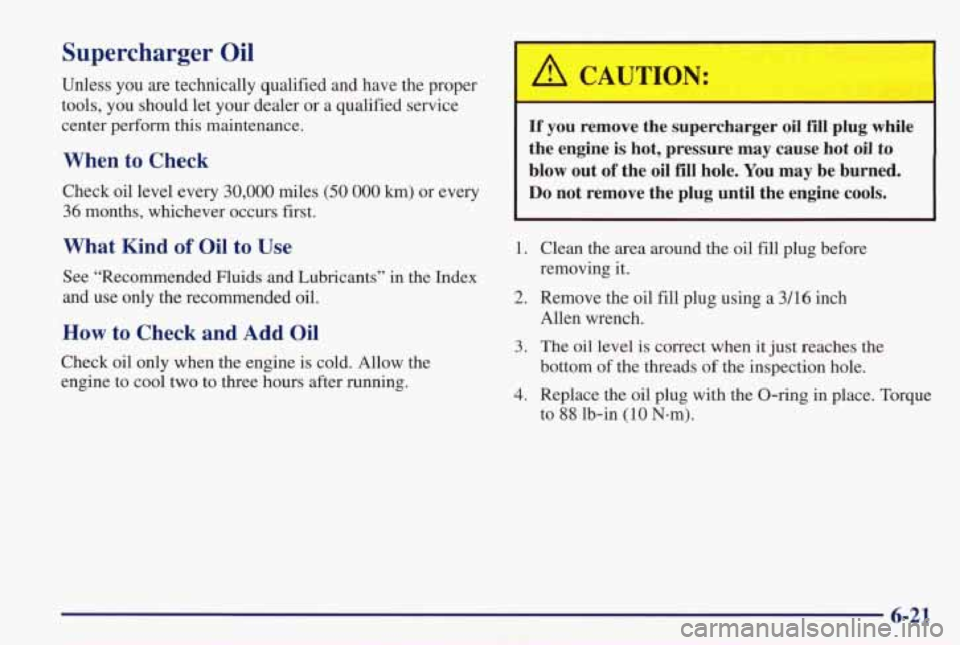
Supercharger Oil
Unless you are technically qualified and have the proper
tools,
you should let your dealer or a qualified service
center perform this maintenance.
When to Check
Check oil level every 30,000 miles (50 000 km) or every
36 months, whichever occurs first.
What Kind of Oil to Use
See “Recommended Fluids and Lubricants” in the Index
and use only the recommended oil,
How to Check and Add Oil
Check oil only when the engine is cold. Allow the
engine to cool two to
three hours after running.
A CAUTION:
If you remove the supercharger oil fill plug while
the engine is hot, pressure may cause hot
oil to
blow out
of the oil fill hole. You may be burned.
Do not remove the plug until the engine cools.
1. Clean the area around the oil fill plug before
2. Remove the oil fill plug using a 3/16 inch
3. The oil level is correct when it just reaches the
bottom
of the threads of the inspection hole.
removing
it.
Allen wrench.
4. Replace the oil plug with the O-ring in place. Torque
to
88 lb-in (10 N-m).
6-21